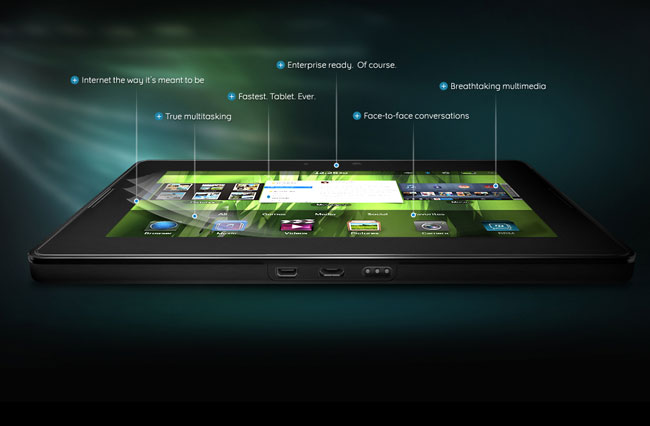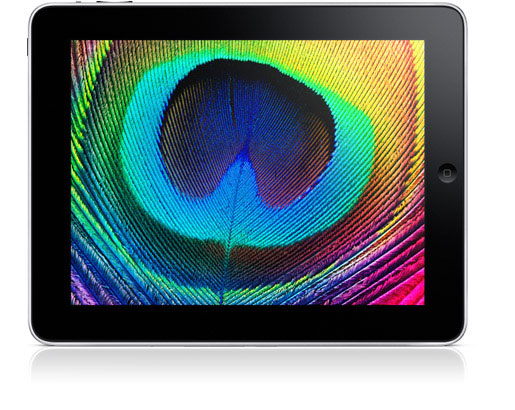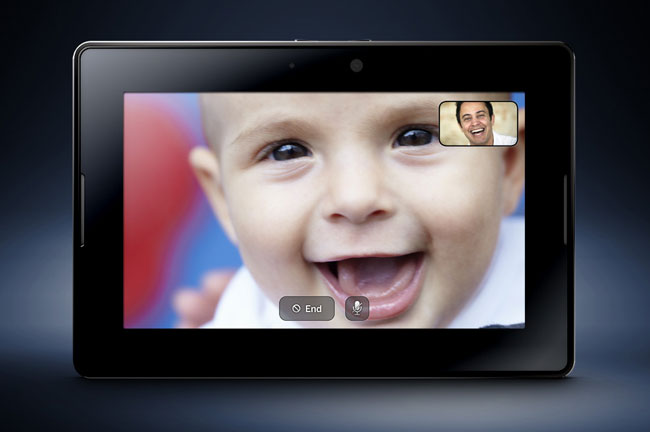

Research in Motion finally announced its long-awaited BlackBerry tablet, the 7-inch PlayBook. Looks very promising so far, lined up against Apple's iPad, Samsung's Galaxy Tab, and the Dell Streak
Both are definitely the same but will the PlayBook become a staple in briefcases everywhere, or is RIM too late to make a difference? We’ll find out in early 2011, when the first PlayBooks arrive, but in the mean time we’ve put the specs for each tablet side by side to see whether BlackBerry’s PlayBook is a like nuclear warhead aimed straight at Apple.
 Portability
Portability
Winner: BlackBerry PlayBook
Not unlike RIM’s phones, the BlackBerry PlayBook will best its Apple equivalent on both size and weight. The seven-inch screen shrinks its top-down footprint correspondingly, but it also loses a tenth of an inch in depth (0.4 inches thick versus 0.5 on the iPad) and weighs 0.9 pounds, less than two thirds the weight of the 1.5-pound iPad.
Processor
Winner: BlackBerry PlayBook
As with most spec-based speed comparisons, this one’s far from cut and dry, but when it comes down to it, the iPad has one core running at 1GHz, the PlayBook has two. The ARM Cortex A9 used by BlackBerry represents a generational shift forward from Apple’s A4, which is based around the Cortex A8 processor. Besides the added computational brawn that comes with a whole extra core, like enabling 1080p video processing, the switch from 65nm to 45nm architecture should also improve battery life on the PlayBook. But there is a remaining question mark: BlackBerry hasn’t announced which graphics chipset it will pair with the A9, which could potentially leave the iPad as the gaming king with its potent PowerVR SGX 535.
 Display
Display
Winner: Apple iPad
RIM has opted for only a seven-inch screen on the BlackBerry, quite a bit smaller than the 9.7-incher on the iPad, but resolution remains surprisingly close: 1024 x 768 on the iPad, and 1024 x 600 on the PlayBook. Essentially, that makes using the PlayBook horizontally like watching a widescreen movie on the iPad – after tearing off the black bars. While it does boast higher pixel density, the iPad still wins on size and theoretical resolution (remember, a larger screen stretches those pixels out more). And while RIM could roll out with a real stunner, it would take a top-spec LCD panel to compete with the best-in-class brightness and viewing angle on the iPad’s IPS LCD screen.
Connectivity
Winner: Apple iPad
The first generation of the PlayBook will only ride on Wi-Fi networks, leaving the 3G-capable iPad looking much more practical for frequent travelers. However, BlackBerry may be sitting on a great deal more potential in the long term. If it follows in the footsteps of BlackBerry phones, future 3G versions of the phone may be carrier-independent, and QNX CEO Dan Dodge even hinted that 4G is not out of the question. However, until hard details on these options come down the pipe, the iPad remains the better-connected tablet.
 Camera
Camera
Winner: BlackBerry PlayBook
Considering Apple’s iPad doesn’t even have a camera, even a cheapo VGA cam in the PlayBook would make this no contest, but RIM has gone above and beyond with some seriously impressive imaging equipment packed in. The PlayBook sports both a front-facing 3-megapixel camera for videoconferencing, and a rear-facing 5-megapixel camera. Even more impressively, the rear cam will shoot true 1080p video – a first for any tablet or smartphone.
Applications
Winner: Apple iPad
Rather than carrying over the latest BlackBerry OS to the PlayBook, RIM opted to start over with the new “Neutrino” OS from QNX, a company it acquired back in April. On the up side, the PlayBook gets a specially designed OS optimized for its seven-inch screen. On the downside, developers will have to start from scratch developing apps for it, rather than granting access to the 10,000 apps already available for BlackBerry smartphones through BlackBerry App World. Meanwhile, the iPad boasts access to 25,000 iPad-optimized apps in Apple’s App Store and growing, plus access to the full 250,000 made for iOS.
While it looks grim for the PlayBook, RIM has promised robust support for Adobe Flash, Adobe AIR and HTML5, which could potentially help fill the void of dedicated apps with Web applications.
Conclusion
RIM can’t hold a candle to Apple’s app collection, but with the PlayBook, it has successfully managed to outspec Apple in a number of key categories. The PlayBook’s small size makes it eminently more portable than the iPad, its high-quality cameras will appeal to business users who want to Skype with family and coworkers from across the globe, and a dual-core processor will even tickle the fancy of performance geeks – not something RIM is used to doing. The PlayBook will also appeal to BlackBerry’s core constituency with the same tight enterprise support as its phones, BlackBerry tethering, and smartphone integration that will allow owners of both devices to switch back and forth between both devices seamlessly – starting an e-mail on a Bold 9700, for instance, then finishing it on the PlayBook.
RIM has also left us with a number of blanks to fill that could tilt the PlayBook in either direction. Which carriers will it come on? Can it match the iPad’s 10-hour battery life? Perhaps most importantly – how much will it sell for?
Until we have those answers – and our hands on the real hardware, we’ll refrain from declaring a winner here, but based on specs alone, it looks like RIM has wheeled out a legitimate challenger, and Apple engineers will have their work cut out for them when they go to revamp the iPad for 2011.
Here are the specs you may consider before buying the "pad"
 BlackBerry PlayBook |  Apple iPad |  Samsung Galaxy Tab |  Dell Streak | |
| Screen size | 7 inches | 9.7 inches | 7 inches | 5 inches |
| Resolution | 1024 x 600 | 1024 x 768 | 1024 x 600 | 800 x 480 |
| Pixel density (approx.) | 170 | 133 | 170 | 187 |
| Platform | BB Tablet OS | iOS 3.2.2 (4.2 in November) | Android 2.2 | Android 1.6 (2.1/ 2.2 in future) |
| Adobe Flash support | 10.1 | Not Supported | 10.1 | Not supported |
| Processor | 1GHz dual-core Cortex A9 | 1GHz Apple A4 (ARMv7) | 1GHz Cortex A8 | 1GHz Snapdragon |
| Graphics | Unknown | PowerVR SGX 535 | PowerVR SGX 540 | Adreno 200 |
| RAM | 1GB | 256MB | 512MB | 512MB |
| Internal Storage | 16GB / 32GB (unconfirmed) | 16GB / 32GB / 64GB | 16GB / 32GB | 2GB |
| Expansion | Unknown | None | microSD | microSD |
| Connectivity | 802.11 a/b/g/n, Bluetooth 2.1 + EDR | 802.11 a/b/g/n, Bluetooth 2.1 + EDR | 802.11 b/g/n, Bluetooth 3.0 | 802.11 b/g, Bluetooth 2.1 + EDR |
| Cellular data | 3G and 4G promised for future | 3G optional (GSM) | 3G (all carriers) | 3G (sold via AT&T) |
| GPS | None | 3G models only | Yes | Yes |
| Camera | 3MP front, 5MP rear | None | 1.3MP front, 3MP rear | VGA front, 5MP rear |
| Weight | 0.9 lbs | 1.5 - 1.6 lbs | 0.84 lbs | 0.49 lbs |

0 comments:
Post a Comment